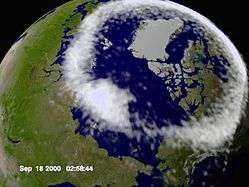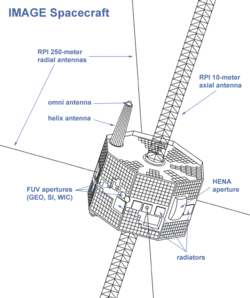IMAGE
|
Diagram of IMAGE spacecraft | |
| Names |
Explorer 78 IMAGE |
|---|---|
| Operator | NASA |
| COSPAR ID | 2000-017A |
| SATCAT № | 26113 [1] |
| Website | http://image.gsfc.jhu.edu/ |
| Spacecraft properties | |
| Manufacturer | Johns Hopkins University |
| Launch mass | 536 kg (1,182 lb)[1] |
| Power | 250.0 watts |
| Start of mission | |
| Launch date | March 25, 2000 [1] |
| Rocket | Delta II 7326[1] |
| Launch site | Vandenberg SLC-2W [1] |
| Orbital parameters | |
| Semi-major axis | 29,815.4 kilometres (18,526.4 mi) |
| Eccentricity | 0.7530800104141235 |
| Perigee | 640.4 km (397.9 mi) |
| Apogee | 46,248.4 km (28,737.4 mi) |
| Inclination | 90.01000213623047° |
| Period | 853.90 minutes |
| Main | |
| Diameter | 2.2 m |
IMAGE (from Imager for Magnetopause-to-Aurora Global Exploration), or Explorer 78, was a NASA MIDEX mission that studied the global response of the Earth's magnetosphere to changes in the solar wind. It was launched March 25, 2000 by a Delta II rocket from Vandenberg AFB and ceased operations in December 2005.
The IMAGE craft was placed in a 1,000×46,000 km orbit around the Earth, with an inclination of 90° (passing over the poles) and a 14.2 hour period. IMAGE was the first spacecraft dedicated to observing the magnetosphere of the Earth, and it produced comprehensive global images of plasma in the inner magnetosphere. It did this using five instruments:
- Neutral Atom Imagers (LENA, MENA, HENA)
- Far-Ultraviolet (FUV) Imaging System
- Extreme Ultraviolet (EUV) Imager
- Radio Plasma Imager (RPI)
- Central Instrument Data Processor (CIDP)
The CIDP as well as the Command & Data Handling Subsystem (main on-board computer) of the craft were built around the mission-proven RAD6000 avionics processors.
Gallery
- Photos of IMAGE
 False-colour image of ultraviolet Aurora australis.
False-colour image of ultraviolet Aurora australis. Picture of the ultraviolet glow from relatively cold plasma surrounding our planet.
Picture of the ultraviolet glow from relatively cold plasma surrounding our planet. False-colour image of ultraviolet Auroral lights from particles excited by collisions with protons, so called Proton Aurora.
False-colour image of ultraviolet Auroral lights from particles excited by collisions with protons, so called Proton Aurora..jpg) IMAGE in preparartion.
IMAGE in preparartion.
See also
External links
- IMAGE NASA page, with tabular presentation of key spacecraft details
- Southwest Research Institute
- NSSDC Master Catalog information on the IMAGE mission
| Wikimedia Commons has media related to IMAGE (NASA mission). |
